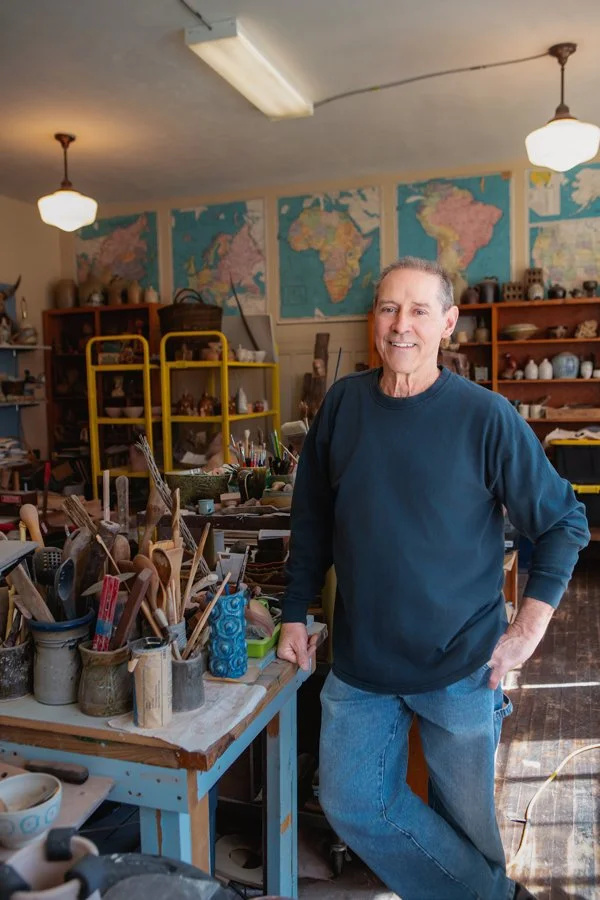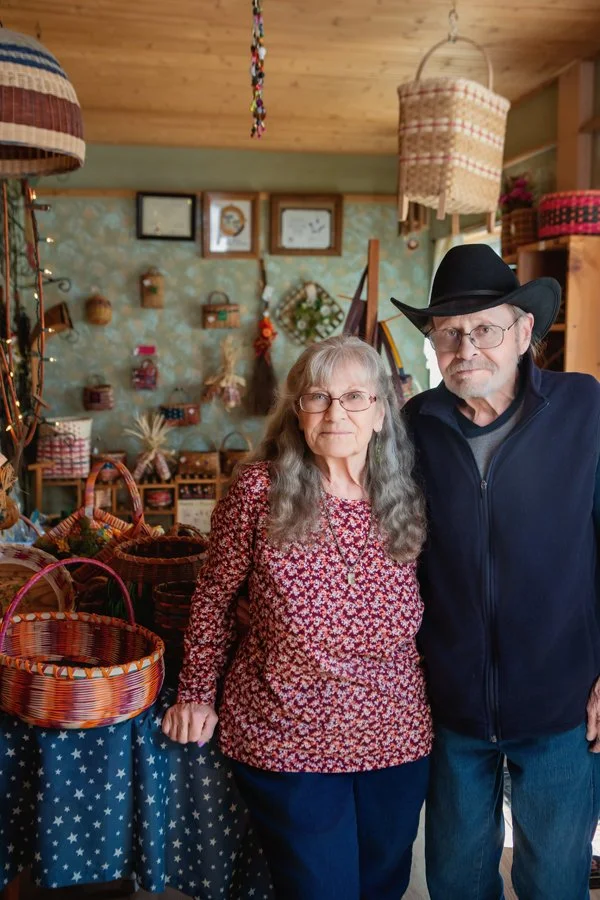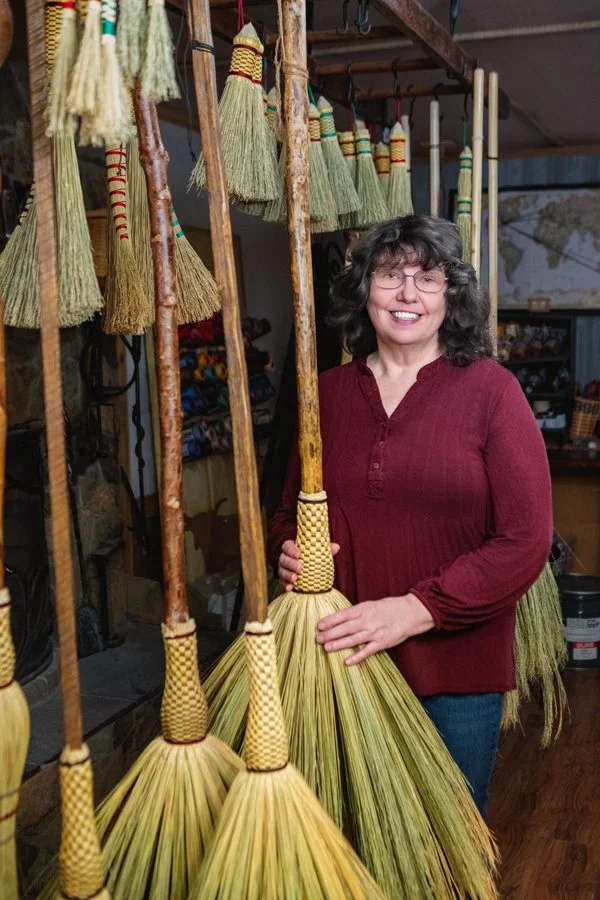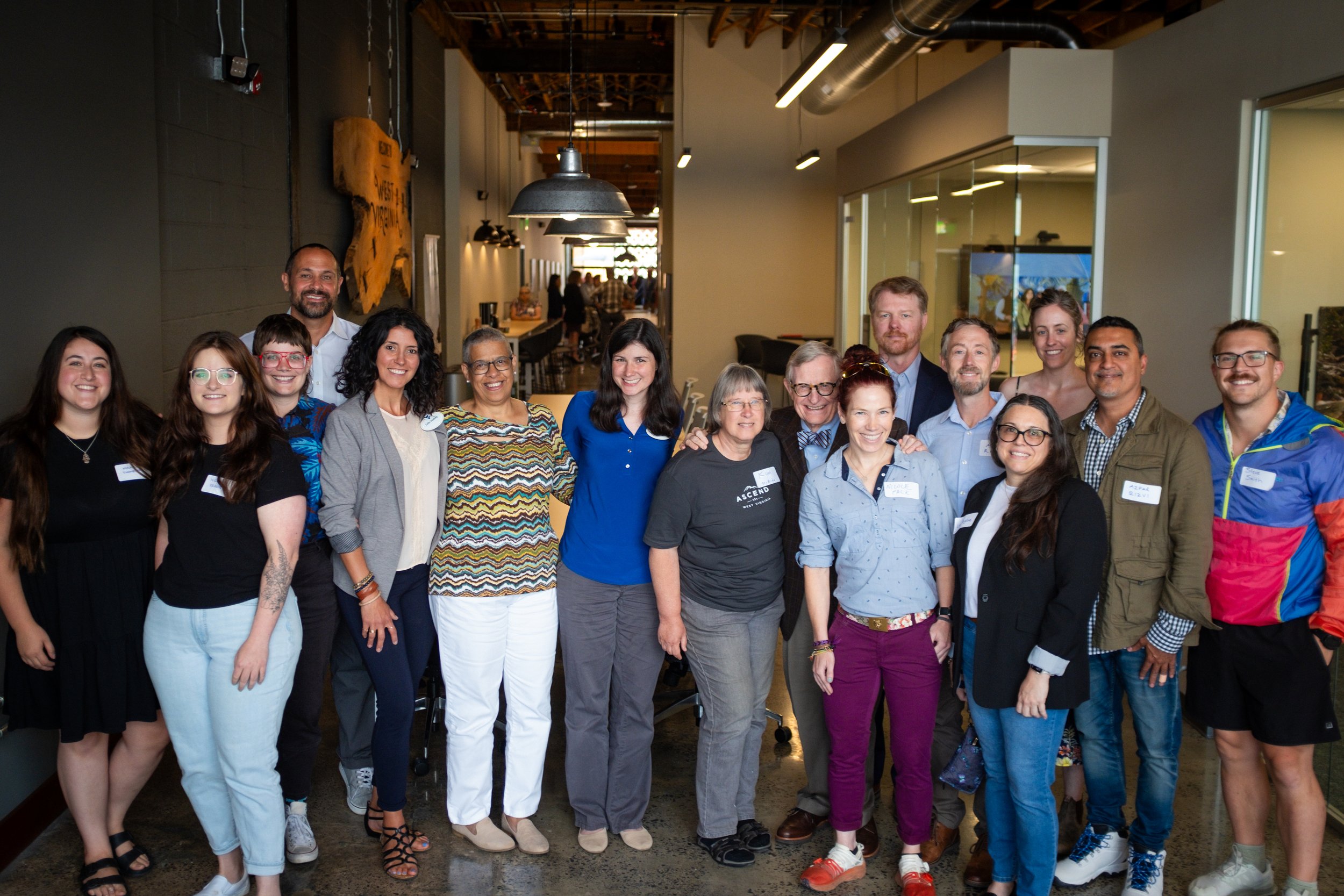The Art Class - 2025

By Amanda Larch Hinchman | Photography by Mary Baldwin
Celebrating our 20th anniversary here at GVQ, we wanted to bring back an old favorite feature: the Art Class. As the Greenbrier Valley is a region unlike any other, with its people wholeheartedly dedicated to fostering and supporting the arts, it’s no wonder we are home to such a wide variety of artists and creatives who feel secure and inspired to make and create here. Each artist, whether from the Mountain State originally or having moved here some time ago, loves and appreciates Mountain Mama’s natural beauty, constantly drawing inspiration to celebrate their artistic freedoms and expressions, often reflected in their art. Read on to meet the members of Art Class 2025.
Sean O’Connell - The Earth Sculptor
Sean O’Connell - The Earth Sculptor
Clay sculptor Sean O’Connell has been making objects all his life, exploring a wide range of interests and ways to work. Changing careers from a carpenter and woodworker to further explore art, he moved to West Virginia in 2013 after studying ceramics in upstate New York. He now operates Jumping Branch Clayworks at Lee Street Studios. “Sculpture was my basis,” Sean says. “I have an affinity for wood, so I started mixing the wood elements with the clay elements and creating these totemic mixed media sculptures.” He’s also always been drawn to the non-industrial energy of cultures that work with clay or wood as a means of expression symbolically. “I like masks,” Sean says. “I like work of Africa, India, China, Japan, New Zealand. The Maori work is incredible. So I’m influenced by all that. I like the idea that you can see the hand of the maker in whatever I make.” West Virginia and Appalachian traditions of pottery are primarily functional, and Sean’s wheel work has a basis here, blending with the figurative work he brings to the table. Each piece he creates is an individual, with a nearly tangible freshness and energy. “I’m not interested in making tight ceramic wear that competes with mass produced, machine made work. I think in this day and age, we appreciate the touch of the human, and that’s one theme that flows through everything I do: that idea of the human maker, the human hand in the creations of history and the world.”
Donald Earley - The Brushstroke Poet
Donald Earley - The Brushstroke Poet
Painting since 1970, Donald Earley was determined from a young age to follow his dreams of becoming an artist. Working as an illustrator, painter, printmaker, sculptor, and instructor, “I try to explore all facets of it,” he says. Moving to West Virginia was one of the greatest experiences of his life; he and his wife fell in love with the place, and it’s no wonder, when Donald can find inspiration everywhere. “It’s an ongoing process, and I enjoy it because I’m reinventing myself each time I move forward to something else,” Donald says. “I can look at the hills or the rolling mountains, the shapes and farms, the colorations, changing of the seasons. It drives me crazy; every time I turn around, there’s something new for me to look at or to explore. I don’t have enough time in my life to capture that moment, so I try to grab just a little portion of it.” Donald’s art is also a blend of the personal and political. “I grew up very immature, in a sense, toward politics. I never looked at it for what it was. I’m trying to record a history of time in my lifetime. I’m not trying to just bypass it. It’s not a style, it’s an emotional reaction. I react differently to most people—artists do react differently. I’m just trying to do my best to understand what’s in front of me.”
Mike and Judy McDade - The Woven Storytellers
Mike and Judy McDade - The Woven Storytellers
Weavers Mike and Judy McDade began Jamit Baskets in 1994, first working from basket kits and pattern books before gaining the experience and confidence to weave baskets on their own. Having been with Tamarack since its beginnings, they’ve woven their way to more than 100 styles of baskets in any color combination imaginable, including egg baskets, bread baskets, wall hangers, market baskets, Easter baskets, laundry baskets, potato baskets, and more, many of which are of traditional Appalachian heritage. “I like doing production work,” Judy says. “Some of the baskets I make still are what I started with. I do utilitarian baskets. Mike does the beauties. A lot of our ideas come from people who want something, so you never know where the road’s going to take you when you weave. We’re not really ever searching out. It seems to find us.” They also do all the dyes themselves, immersing themselves in the process. “There’s no end to baskets,” Mike says. “You hear about a mom and pop business, that’s what we are.” Jamit Baskets ships everywhere and accepts custom orders. “They’re a good gift to give because you can get something made special, and it’s lightweight and doesn’t break easily,” Judy says. Both in their 70s, the McDades are thinking about starting a school and passing down their knowledge. “I guess we’ll just keep weaving,” Judy says. “They’ll find us in a chair somewhere with a basket half finished in our hand. Please, somebody finish it!”
Nathan Seldomridge - The Sound Shaper
Nathan Seldomridge - The Sound Shaper
Playing professionally for a decade and writing almost as long, guitarist Nathan Seldomridge blends Americana folk and alt country in his music. With some exciting things in the works, his debut song “Broken Pieces” is now out on Spotify. West Virginia born and raised, he was heavily influenced by classic country as well as the blues growing up. The Mountain State has also influenced his art, “I think in more ways than I even realize,” Nathan says. “West Virginia has such a storied history, culture, beautiful landscapes, and even the old time music and bluegrass that came out of here, they were all things I probably took for granted growing up. When you’re writing a song, and you’re coming from this place of where you’ve been, it’s sort of inseparable in a lot of ways. And the struggles West Virginia has faced are things I write about a lot, too: economic hardship, addiction, loss, being overlooked or misunderstood. Those are very thematic in my songwriting.” Playing live throughout the state, Nathan takes his rehearsals seriously, spending as much time in the studio rehearsing as on the stage. “I really believe the only difference between where somebody is now and where they want to be is the hours they spend doing something. There’s a charm in every venue you go to. Every venue has its own unique crowd and its own sort of challenges, and those are things I’ve grown to learn to love and accept as part of it.”
Kathleen DeRouen - The Layered Visionary
Kathleen DeRouen - The Layered Visionary
Mixed media artist Kathleen DeRouen has come full circle. Now a permanent artist at the Alderson Artisans Gallery, she took an art journaling course during a retreat years ago and recently taught an art journaling class of her own. Crafty her whole life, using art as a way to reflect and process made the biggest difference for her. “What stuck was using stencils and acrylics and silhouettes to paint a scene or what I was feeling,” Kathleen says. “As I’m reflecting and processing, trying to be a strong woman in the world, I like to use images of women in different poses. I started using magazine images I wanted to emulate, and now I’ve convinced my friends to let me take their pictures and taken my own picture to use as a way to get across what I want to show—it’s showing up in the world as a strong, independent woman.” Working in mixed media, Kathleen uses stencils and scavenges magazines and calendar images. “I try not to buy new things if I can unless they can be used over and over.” A Georgia O’Keeffe quote has heavily inspired her. “‘I found I could say things with color and shape that I couldn’t say any other way, things I had no words for,’ and whenever I’m struggling with a piece, I often go back to that,” Kathleen says. “I don’t have very many words, but being able to express what I’m feeling with color and shape has been life changing.”
Shea Newton - The Treasure Maker
Shea Newton - The Treasure Maker
Drawn to metals and taught to weld as a teen, jeweler Shea Newton, a graduate of the Tyler School of Art at Temple University, “knew right away I wanted to work with metal and got into the jewelry field through my major, and I loved it,” Shea says. “I found work right out of school in the industry.” Working in the Jewelers’ Row District in Philadelphia for retail shops, she eventually started her own business. Now living in West Virginia for 10 years, Shea creates her own designs as well as custom pieces for customers. “I divide my time between hand fabricating and doing computer-aided design,” she says. “For custom work, people bring me heirloom jewelry; I like to work from what you have in your jewelry box or what was passed down.” Recently, Shea opened her own retail shop in downtown Lewisburg with her workshop still located on her family farm in Summers County. She loves the freedom of her business. “I am inspired by nature, the people and the culture, the beauty that is here, truly,” she says. Shea continues to improve her craft, working with a variety of metals, taking stone setting courses and starting her own line of hand fabricated pieces to tour across the state at festivals and shows. “Most of my handmade pieces I’m making from wire and sheet and sawing and soldering and setting stones. I’m starting to really build my bench skills, so I can do all the work myself.”
Brenda Harmon - The Keeper of Tradition
Brenda Harmon - The Keeper of Tradition
Brenda Harmon, owner of BrenWood Forge and Broom, began her craft when her husband, a blacksmith, needed a broom to go with a fireplace tool set he’d made. Everything snowballed from there. “I purchased a broom at a flea market, tore it apart and figured out how to make it basically by trial and error,” Brenda says. Making brooms as a business for just shy of 20 years, Brenda took classes at the John C. Campbell Folk School. “I was able to be creative, and it complimented my husband’s iron work,” she says. “We started doing craft shows and events, and that’s where we started to build our business.” Harvesting some broom making material from the woods, Brenda also uses nylon twine and broom corn from Mexico and practices techniques from days of old. “I use better materials in this day and age, but I use the same process of hand tying the broom like they did in the late 1700s with a foot pedal,” she says. “The brooms I make are from prior to that industrial revolution. The brooms I make just have such a warm, good feel to them that they’re beautiful to look at, they’re fun to use. They make it so I enjoy sweeping. It’s just a homey, feel good feeling to use.” In addition to traditional brooms that are as beautiful as they are practical, Brenda makes and sells pot scrubbers, percussion brushes, holy water sprinklers, and much more, shipping all over the world.
Thomas Ruggiero - The Textile Architect
Thomas Ruggiero - The Textile Architect
Fashion designer Thomas Ruggiero combats fast fashion by curating one-of-a-kind designs from secondhand and salvaged fabrics and materials. His custom work is designed to outlive its buyers. “What I do here is really upcycle textiles that have been forgotten or left in the dust, that now here I am taking all my training and talents, even though I think anyone can sew, and making something that feels contemporary and is something you will have for your lifetime,” Thomas says. Always drawn to the everyday production of fashion, before moving back to West Virginia and opening his studio at Lee Street Studios, Thomas worked in the fashion industry in New York City but became discouraged by the amount of fabric waste and textile misuse he experienced. One of Thomas’ most recent projects was designing First Lady Denise Morrissey’s inauguration gown. “I had never anticipated doing special events dresses because I love to make the things you can wear every day,” Thomas says. “I like upcycling these textiles and giving them a second life.” In addition to prints and illustrations, some of his signature creations are making coats from wool blankets. No matter what garment he designs, “it’s of a higher quality, it’s a one-of-a-kind piece,” Thomas says. “No one else is going to have it.” He’s not on social media; instead, find Thomas at markets throughout the state or in his studio where he accepts custom requests, as well as teaching sewing and printmaking at Carnegie Hall.
Kristen Rehak - The Ink Sorcerer
Kristen Rehak - The Ink Sorcerer
Black Possum Ink owner and hand poked tattoo artist Kristen Rehak started her tattooing journey on a whim, finding a way for more self-expression and originality in her art. Kristen enjoys the process more than machine tattooing, allowing her more control over the end product. Taking inspiration anywhere, she offers custom and premade flash tattoos of her own designs, including themed flash collections corresponding with social or political issues, using them as a fundraising opportunity toward a cause or organization. Her style is constantly evolving, changing as she grows as an artist. “I primarily do a lot of graphic line work, and I like to incorporate some old school traditional tattoo elements and themes into my flash because I love traditional style tattoos,” Kristen says. Collaborating and connecting with clients is a highlight for her, even as she jokes—and her business name pays homage to—the idea she’s the black sheep of the local tattoo community. “When people approach me with ideas and they want something in my style or to make an idea my own, those projects end up being the best. I get to create some original artwork, and the client gets to see their idea come to life,” Kristen says. “I try to incorporate my own style into most projects, even if it’s just adding or changing a few details; I want designs to be unique in some kind of way for my clients. Luckily, most people want unique tattoos—people want to know their tattoos are special and handmade for them.”













